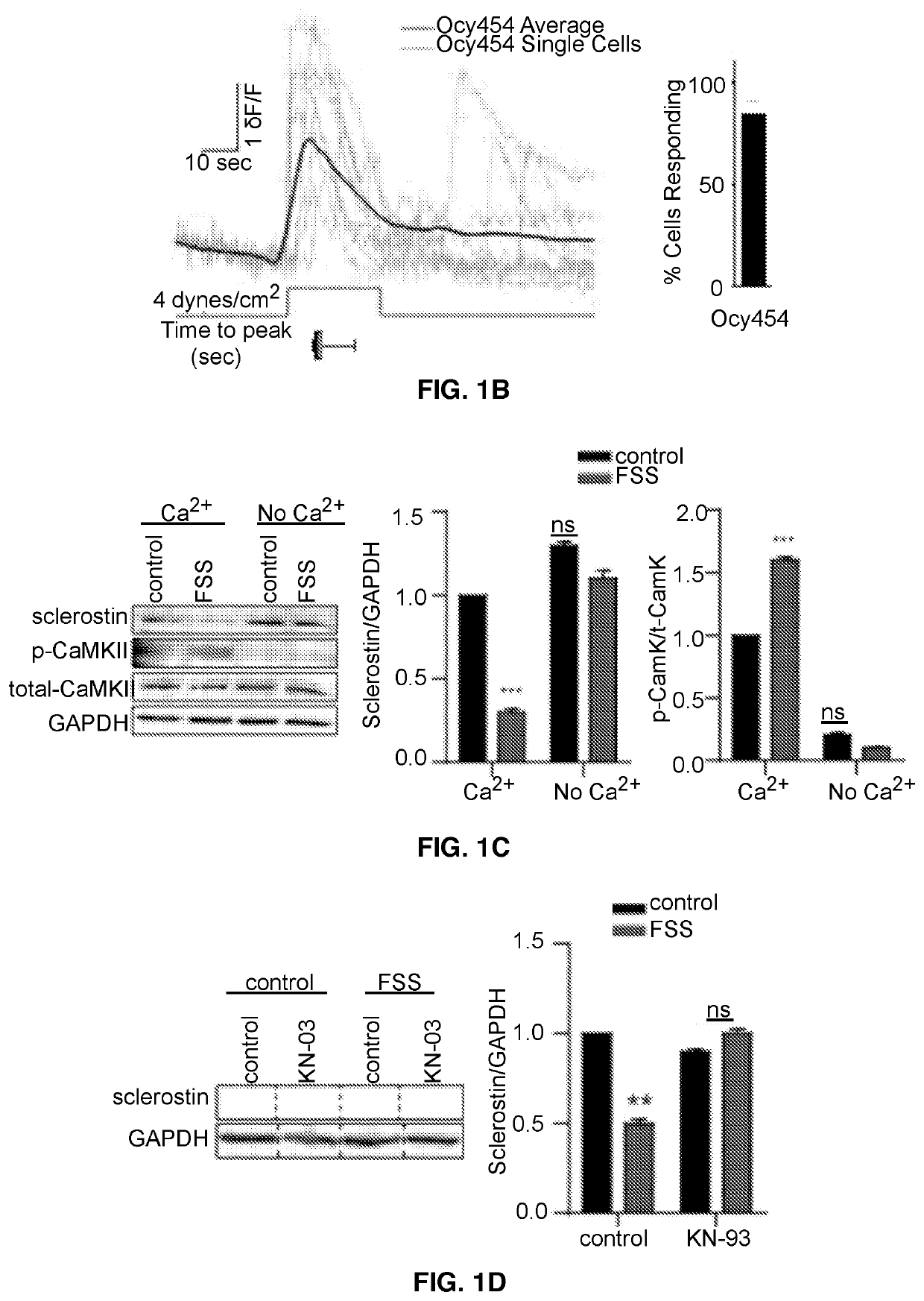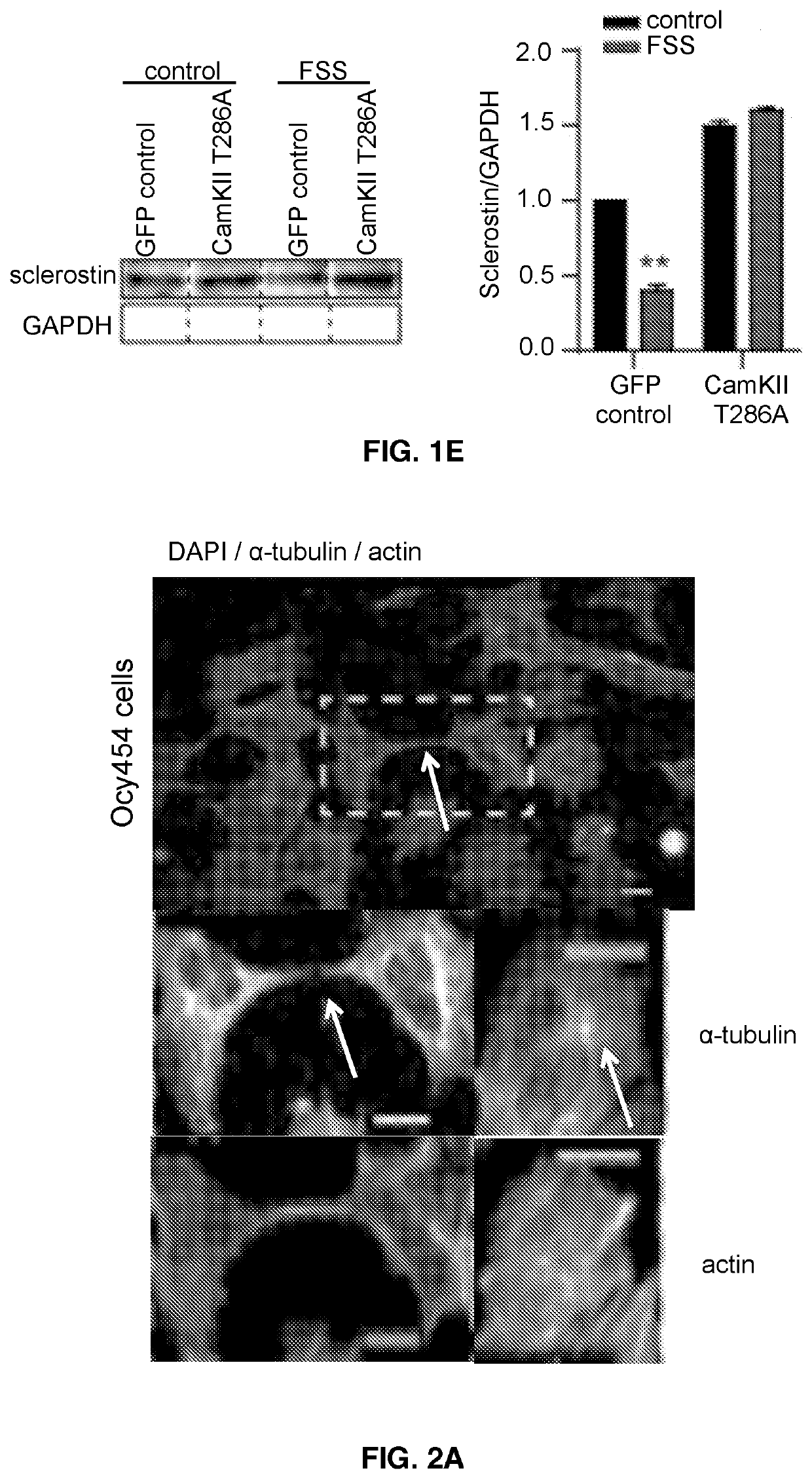Methods for Treating Bone-Related Disorders
a bone-related disorder and treatment method technology, applied in the field of medicine, can solve the problems of increased fracture risk, low bone mass and/or quality, and low bone quality, and achieve the effects of restoring mechano-signal, reducing fracture risk, and reducing fracture risk
- Summary
- Abstract
- Description
- Claims
- Application Information
AI Technical Summary
Problems solved by technology
Method used
Image
Examples
example 1
Materials and Methods
Chemicals and Reagents
[0049]Taxol, colchicine, GSK2193874, GSK-1016790A, N-acetylcysteine, and parthenolide were purchased from Sigma. BAPTA AM ester was from Cayman Chemical. GP91ds-TAT was from Anaspec. SiR-tubulin was from Cytoskeleton, Inc. CellROX Deep Red Reagent and Fluo-4AM ester were purchased from ThermoFisher.
Cell Culture and Treatments
[0050]Osteocyte-like Ocy454 cells (provided by Dr. Divieti-Pajevic, Boston University) were cultured on type I rat tail collagen (BD Biosciences) coated dishes in α-MEM supplemented with 5% FBS. Cells were maintained at 33° C. and 5% CO2. Prior to experiments cells were seeded into a tissue culture treated vessel and maintained at 37° C. and 5% CO2 overnight. For alteration of the MT network, cells were pretreated with 0.1% DMSO (control), colchicine (2 mM, 20 min), Taxol (1 mM, 2 h), or PTL (25 mM, 2 h). In the case of the combined treatment, cells were dosed with PTL for 30 min before Taxol was added to the same media...
example 2
[0060]Ocy454 Cells Respond to FSS with a Rapid Increase in Intracellular Ca2+ that is Required for CaMKII Phosphorylation and the Mechanically-Induced Decrease in Sclerostin
[0061]Unlike some of the commonly used osteocyte cell lines, the Ocy454 osteocyte line, derived from the Immortomouse, reliably produces detectable sclerostin protein and is sensitive to mechanical stimuli (27). In Ocy454 cells loaded with the Ca2+ indicator dye Fluo-4AM, fluid shear stress at 4 dynes / cm2 elicited a rapid, transient increase in intracellular Ca2+ concentration in ˜84% of cells (FIGS. 1A-1B), resulting in activation of CaMKII and a concomitant 3-fold decrease in sclerostin protein observed within 5 minutes post-fluid shear stress (FIG. 1C). The fluid shear stress-induced CaMKII phosphorylation and decrease in sclerostin protein was inhibited when Ca2+ signaling was blocked by loading the cells with BAPTA AM and removing Ca2+ from the fluid flow buffer (FIG. 1C), demonstrating that Ca2+ was require...
example 3
Microtubules are Present in the Putative Mechano-Sensitive Structures of Ocy454 Cells
[0062]The cytoskeleton, comprised of actin, microtubules and intermediate filament networks, is a dynamic structural and signaling scaffold within all cells. A key function of the cytoskeleton is to transmit mechanical forces to proteins and enzymes that generate biological signals during mechanotransduction. In other cell types, microtubules have been implicated in mechanotransduction-elicited Ca2+ signaling (28-30). In bone cells, an intact microtubule network is required for mechano-sensation by osteoblasts or osteocytes in culture (31-34), and the microtubule network of osteocytes remodels and reorients itself in response to FSS (34-36). Additionally, microtubules are an important component of the primary cilia, which has been proposed to be a mechano-sensor in osteocytes (16, 37). Another putative mechano-sensitive component is the long cellular process, extending from the cell body of the oste...
PUM
 Login to view more
Login to view more Abstract
Description
Claims
Application Information
 Login to view more
Login to view more - R&D Engineer
- R&D Manager
- IP Professional
- Industry Leading Data Capabilities
- Powerful AI technology
- Patent DNA Extraction
Browse by: Latest US Patents, China's latest patents, Technical Efficacy Thesaurus, Application Domain, Technology Topic.
© 2024 PatSnap. All rights reserved.Legal|Privacy policy|Modern Slavery Act Transparency Statement|Sitemap



